Exploring the Depths of Red Orange Crystals
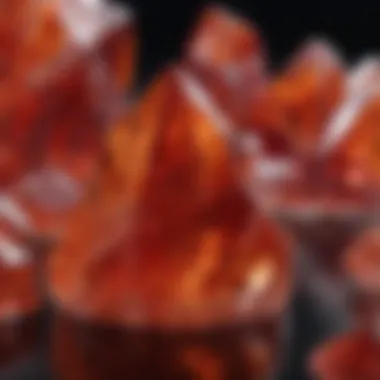

Intro
In the colorful universe of gemstones, red orange crystals stand out with their vibrant hues and distinctive charm. These stones not only captivate the eye but also hold a rich history and a myriad of uses spanning cultures and ages. Understanding these gems can feel like embarking on a journey, as each facet reveals something unique and remarkable. This exploration aims to illuminate the various aspects of red orange crystals, from their geological origins to their impact on modern jewelry and metaphysical practices.
Gemstone Overview
Definition and Characteristics
Red orange crystals refer to a specific group of gemstones that exhibit warm, fiery tones, ranging from deep crimson to bright apricot. Their distinct coloration arises from trace elements such as iron and chromium, which lend depth and vibrancy to their appearance. Common types in this spectrum include carnelian, fire opal, and spessartine garnet, each bringing its own unique characteristics to the table.
Key Characteristics:
- Color Variations: The spectrum includes various shades, giving rise to work in jewelry design.
- Transparency Levels: These gems can range from translucent to almost opaque.
- Hardness Scale: Most red orange crystals rate between 5 and 7 on the Mohs hardness scale, signifying their durability.
When light interacts with these stones, it can produce breathtaking visual effects known as pleochroism, where the color changes depending on the angle of viewing. This play of light becomes a talking point not just in collector circles, but also in casual conversations among enthusiasts.
Classification of Gemstones
Understanding how red orange crystals are classified aids significantly in appreciation and valuation. Gemstones, in essence, can be classified into two primary categories:
- Precious Gemstones: This includes diamonds, rubies, sapphires, and emeralds—stones valued primarily for their rarity and quality.
- Semi-Precious Gemstones: Red orange crystals predominantly fall into this category. They, too, can be rare but are generally more abundant than their precious counterparts.
Moreover, gemstones are further classified based on their chemical composition, crystal structure, and origin. This classification is essential not only for scientific purposes but also for potential buyers and collectors looking to build their own unique collections.
Historical Significance
Ancient Uses and Cultural Importance
The historical significance of red orange crystals spans centuries and civilizations. Ancient cultures often revered these stones, believing they possessed mystical properties and benefits. For instance, carnelian was used in ancient Egyptian jewelry and burial items, symbolizing vitality and the afterlife. It was thought to protect the wearer from evil and to enhance courage—traits highly valued in warriors and leaders.
Similarly, in Indian culture, orange stones like fire opal are often linked with good fortune. Traditional practices integrate these gemstones in rituals aimed at harnessing energy and promoting prosperity.
Myths and Legends Surrounding Gemstones
Every gem carries with it a tapestry of myths and legends. Red orange crystals are no exception.
"To hold a red orange crystal is to embrace the warmth of the sun and the fiery spirit of ancient earth."
It is said that spessartine garnet has the ability to restore one's zest for life, enhancing creativity and stimulating the mind. Many artists and creators have turned to this gem, believing it fuels their inspiration and motivation.
These legends contribute to the allure of the stones, enriching not only personal connections to the gems but also their market value. Collectors often seek these stones not just for their aesthetics but for the tales that accompany them.
Prolusion to Red Orange Crystals
Red orange crystals hold an exceptional place in both the world of geology and the realm of metaphysical beliefs. This specific category of gemstones captivates enthusiasts due to their vivid hues and unique properties. Understanding them invites deeper engagement with their beauty and significance, enticing both collectors and jewelry designers. The topic here not only traces the physical characteristics of these crystals but also explores their cultural subtext and emotional resonance.
The interplay of scientific discovery and artistic expression forms the essence of the discussion surrounding red orange crystals. Their distinct shades, blending red and orange, suggest vitality and warmth, appealing to those who appreciate both aesthetics and the stories behind each stone. By delving into their geological formation, visual traits, and the narratives that cultures have woven around them, we gain a multifaceted perspective that enriches our appreciation.
In this exploration, we will focus on:
- Cultural Symbolism: How these crystals have been valued across different societies, their meanings, and associated beliefs.
- Geological Insights: The processes that bring forth these stunning gems from the earth's depths.
- Market Relevance: Analyzing trends that enhance their desirability in today's jewelry designs.
Red orange crystals are not just pretty stones; they are archives of history, touchstones for emotional well-being, and catalysts for creativity. As we traverse this landscape, we will uncover what makes these gems not only collectible but also worthy of thoughtful consideration.
Definition and Overview
Red orange crystals are typically gems that exhibit a dynamic range of colors, from deep crimson to warm amber. Gemstones like garnet, fire opal, and carnelian fall into this captivating spectrum. Each crystal possesses its own distinct mineral composition and structure, contributing to varying light refractions, inclusions, and overall clarity.
This dichotomy in color, while visually stimulating, also mirrors a playful interaction of light. As the light hits the surface at different angles, the stone can reveal a fiery glow that seems to pulse with energy, drawing the viewer closer.
While defining red orange crystals, one might consider:
- Common Types: Garnet, cornaline, and fire opal, to mention a few.
- Physical Properties: Which include hardness, refractive index, and crystal systems that characterize these gems.
Grasping the definitions and the intrinsic qualities of these stones lays the groundwork for appreciating their multifaceted role in various cultures.
Cultural Significance
Historically speaking, red orange crystals have been steeped in meaning across numerous civilizations. They have been heralded not only for their beauty but also for their perceived metaphysical properties. Ancient cultures often associated specific crystals with divinity, healing, and power.
For instance, within the realms of mythology and symbolism:
- Garnet: Often viewed as a warrior's stone, believed to provide safety and courage during the battle.
- Carnelian: Revered in ancient Egypt for its healing properties and thought to ensure protection in the afterlife.


The prevalence of these stones in artifacts and jewelry serves as testament to their importance. People adorned themselves with red orange crystals not just to flaunt status, but as tokens of protection, fertility, and successful transitions in life, showing how deeply intertwined culture and stone can be.
"Crystals are the earth’s way of putting time in a bottle, capturing centuries of geological stories."
This introductory exploration of red orange crystals sets the stage for deeper investigations into their geological origins, visual traits, and broader implications in today's world.
Geological Formation
Understanding the geological formation of red orange crystals is crucial for collectors and enthusiasts alike. These crystals don't just randomly appear; they are the result of specific natural processes governed by the laws of physics and chemistry. Awareness of how these gemstones are created can deepen appreciation for their beauty and rarity.
Mineral Composition
The mineral composition of red orange crystals can vary significantly. Common minerals involved include quartz, garnet, and topaz, each contributing unique attributes to the final crystal's appearance. For instance, when iron oxide combines with quartz, a beautiful red hue can emerge, bringing forth stunning variations in saturation.
Some notable minerals include:
- Citrine
A variety of quartz known for its vibrant yellows and oranges and occasionally reddish tones. - Andalusite
Often presents in shades of red and orange, this mineral showcases a pleochroism effect, creating fascinating color interplay with light. - Spessartine Garnet
Characterized by its vivid orange color and often found in metamorphic rocks, it forms in high-temperature environments.
The intricate interplay of these minerals not only shapes the color but also influences other properties such as hardness and transparency. Understanding these components can guide enthusiasts in identifying authentic specimens and differentiating them from imitations.
Formation Processes
The processes behind the formation of red orange crystals are equally fascinating. They can arise from igneous, sedimentary, or metamorphic environments. An igneous process, for instance, might see minerals crystallizing from molten rock, slowly cooling to form beautiful structures in larger geodes. Alternatively, a metamorphic process may involve existing minerals being subjected to high heat and pressure, altering their structure and yielding vivid tones over time.
Key processes include:
- Cooling of Magma
As magma cools, minerals crystallize and settle, leading to the formation of red orange gems within granite formations. - Sedimentation and Erosion
Over millennia, the wearing down of rocks releases minerals that can combine in alluvial deposits, creating rich layers. - Metamorphic Reactions
The transformation of rock under pressure creates new minerals, sometimes resulting in breathtaking reds and oranges through chemical alterations.
"Every gemstone tells a story, and the geological processes behind red orange crystals weave a narrative of time, pressure, and elemental interaction."
The awareness of these processes not only enhances the understanding of crystal formation but also illustrates their rarity and value in the market. Knowledge about where and how these gems form adds an additional layer of appreciation—both for collectors and for those interested in the geological sciences.
Visual Characteristics
Understanding the visual characteristics of red orange crystals not only enhances appreciation but also aids in careful selection for collectors and designers alike. The distinct shades and formations can vastly influence both the aesthetic value and market demand. Let’s peel back the layers to see what makes these stones truly stand out.
Color Variants and Rarity
Color plays a crucial role in the charm of red orange crystals. Variants in hue can range from vibrant, fiery reds to softer, muted oranges. This spectrum is often determined by the presence of trace minerals during the crystallization process. For example, the levels of iron can significantly shift the color, explaining why one garnet might radiate deep crimson tones while another glows with a bright, sun-kissed orange.
The rarity of certain shades can elevate a crystal's status. Specifically, crystals that feature a rare combination of colors—like deep red with orange tints—are sought after by collectors. On occasions, a seemingly minor shade variation can cause seismic spikes in market value, shifting a stone from merely beautiful to exceptionally coveted.
Here are a few examples of popular red orange crystals and their characteristic colors:
- Carnelian: Known for its warm orange-red hue; vibrant and striking.
- Fire Opal: Offers a play of color that includes reds and oranges, often with hints of yellow.
- Spessartite Garnet: Ranges from bright orange to deeper reddish oranges, unique in the crystal world.
"Color represents the emotional essence of beauty and nature; it’s the heart that beats within every crystal.”
Clarity and Cut Quality
Clarity and cut are integral to the overall appeal of red orange crystals. Clarity refers to the presence of any inclusions or blemishes that may affect the stone's brightness. In the gemstone community, clearer stones are often seen as superior. A crystal with minimal inclusions is more likely to reflect light, offering that sparkle that mesmerizes the beholder.
Cut quality concerns how well a gemstone is shaped and polished. An expertly cut crystal enhances the color and clarity by maximizing light performance. Different cuts can lend various qualities; for instance, a round cut creates a classic elegance, while an oval or pear shape might emphasize the body color effectively.
Here is a brief rundown on cut styles:
- Brilliant Cut: Maximizes light reflection, enhances clarity.
- Step Cut: Gives a vintage feel, best for emeralds or other crystals with natural clarity.
- Cabochon Cut: Showcases the stone’s natural surface, often utilized for opaque stones.
Lovers of red orange crystals should prioritize stones that reflect light beautifully. A deeper understanding of clarity and cut helps enthusiasts build collections with both aesthetic and potential investment value in mind.
Metaphysical Properties
The allure of red orange crystals extends far beyond their visual appeal; they are steeped in metaphysical significance that intrigues many enthusiasts and collectors. These stones are believed to hold the power to influence feelings, thoughts, and even physical health. For those looking to discover their spiritual dimensions, understanding the metaphysical properties of red orange crystals can greatly enhance their appreciation and usage.
Healing Attributes
Red orange crystals, notably stones like Carnelian and Fire Opal, are often celebrated for their purported healing attributes. They are thought to vibrate at frequencies that resonate with the body's energy centers, commonly referred to as chakras. Here are some of the claimed healing benefits:
- Physical Activation: These crystals are traditionally used to stimulate energy flow, assisting individuals who feel sluggish or imbalanced. Many believe they can boost libido and enhance courage, quite like a warm cup of coffee on a dreary morning.
- Pain Relief: There are anecdotes suggesting that holding or wearing these crystals may help alleviate physical discomfort, such as menstrual cramps or muscle soreness. While scientific backing is sparse, the placebo effect is a powerful ally.
- Detoxification: It's commonly said that these stones assist in purifying the body, helping draw out toxins and promote overall well-being.
Ripple effects from these physical benefits can lead to an improvement in one's emotional state. It’s quite fascinating how something as beautiful as a gemstone can intertwine with our health. The belief is that working with red orange crystals can accord not just physical healing but create a holistic approach to health.
Emotional and Spiritual Benefits
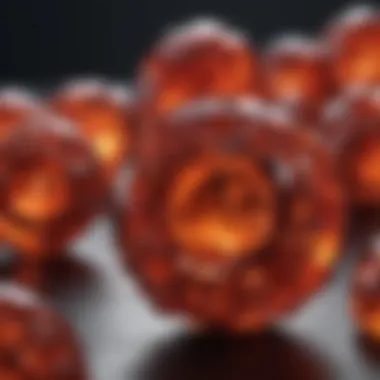
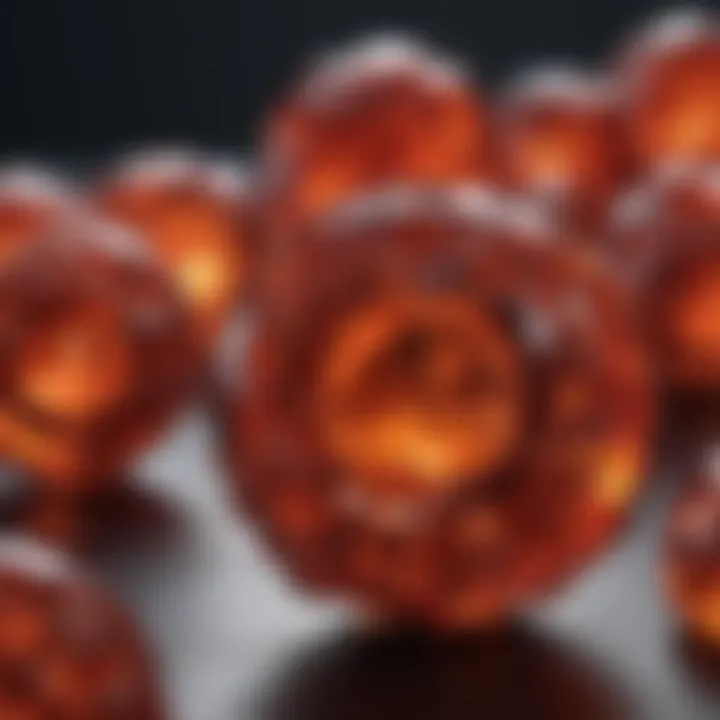
The emotional and spiritual benefits of red orange crystals border on the transformative. The stones are often seen as conduits for amplifying positivity and dispelling negativity, shaping them as valuable tools in a spiritual arsenal.
- Boosting Creativity: Many artists swear by the inspirational properties of these crystals. They claim that the energetic warmth can ignite the embers of creativity, leading to bursts of innovation and spontaneity. If you find yourself stuck in a rut, a Carnelian placed near your workspace might just do the trick.
- Promoting Courage and Confidence: The vibrant hues of these stones are believed to infuse wearers with an inner courage. They may help individuals confront their fears, making it easier to stride into new ventures or tackle daunting challenges.
- Fostering Emotional Healing: Holding or meditating with red orange crystals can evoke powerful emotional cleansings. They are often used in practices aimed at releasing past traumas and fostering a sense of self-love and acceptance.
"Crystals aren’t just pretty rocks; they are tools for deeper connection, self-discovery, and emotional cleansing."
In summary, the metaphysical properties of red orange crystals serve as reminders of the intricate relationship between inner peace and external beauty. By understanding their healing attributes and emotional benefits, collectors and crystal enthusiasts can elevate their spiritual practices and appreciate the stones on a more profound level.
Historical Context
Understanding the historical context surrounding red orange crystals is paramount for appreciating their multifaceted role in human culture, art, and economics. These vibrant gemstones have been part of our natural heritage for untold millennia, woven into the very fabric of folklore and spirituality. They have served not only as adornments but also as powerful symbols of status, protection, and believed metaphysical properties. By exploring their historical importance, we not only unearth the stories embedded within these stones but also grasp the value and relevance they have maintained through various epochs.
Use in Ancient Cultures
From the Neolithic era to the height of the Roman Empire, red orange crystals, particularly those like carnelian and garnet, found a prominent place in various ancient civilizations. For instance, in ancient Egypt, these stones were revered and often used in burial artifacts, symbolizing rebirth and immortality. The Egyptians believed that red orange crystals could protect the deceased in the afterlife. They adorned sarcophagi and jewelry with these vivid stones, merging beauty with spiritual significance.
Similarly, in Mesopotamia, carnelian was often etched with intricate designs and worn by the elite as a marker of power and influence. In those times, such gemstones were not simply jewelry; they were charm-laden talismans embedded with personal and societal meanings. Women, in particular, would sport these gemstones to signify fertility and emotional strength.
The use of red orange crystals transcended boundaries and cultures. In India, where gemstones were cherished for their astrological properties, these crystals were linked to the planet Mars, which symbolizes energy and ambition. Historical texts suggest that red orange crystals were utilized in rituals and meditation practices, aiding seekers in channeling personal strength and vitality.
Red orange crystals have not just adorned bodies but have illuminated souls across civilizations.
Evolution of Jewelry Trends
As time marched forward, the allure of red orange crystals led to a dynamic evolution in jewelry trends. In the Middle Ages, these stones became associated with nobility, often seen in royal regalia and heraldic symbolism. The brilliance of garnets and topaz dazzled courts, where they were crafted into elaborate rings, brooches, and necklaces, hinting at wealth and power.
The Renaissance swiftly followed, bringing with it a flourish of artistic expression. Jewelers began to experiment with innovative cuts and settings, incorporating red orange stones in combination with diamonds and pearls. This era saw the birth of intricate designs that not only highlighted the brilliance of the red orange tones but also showcased the gem's unique character.
During the modern period, the emerging Art Deco movement placed an emphasis on bold shapes and vivid colors. Red orange crystals regained popularity, with their rich hues perfectly complementing the geometric aesthetics of the time. Designers were drawn to their vibrancy, creating statement pieces that became coveted treasures among collectors.
Today, we see a resurgence of interest in red orange crystals, particularly within bohemian and eco-friendly jewelry sectors. More artisans are drawn to the natural appeal of these stones, using them as focal points to craft unique, handmade jewelry that reflects personal style while honoring old traditions.
In summary, the journey of red orange crystals through history not only enriches our understanding of gemstones but also reflects the shifting tides of human expression, spirituality, and identity. The significance attributed to these stones showcases the intrinsic connection between humanity and the natural world, gathering meanings and values over time.
Modern Applications
The realm of red orange crystals has seen a notable shift in how they are perceived and utilized in contemporary society. Beyond mere ornamentation, these gemstones are now woven into the fabric of various sectors, showcasing versatility that captures the interest of designers, artists, and enthusiasts alike. Understanding the modern applications of red orange crystals not only highlights their intrinsic beauty but also underscores their emerging relevance in today's market.
Fashion Trends in Jewelry Design
In recent years, red orange crystals have carved out a niche in the jewelry scene, becoming increasingly favored for their vibrant hue and unique appeal. Designers are using them as statement pieces that can elevate even the simplest attire. The combination of these crystals with metals like gold or silver creates striking contrasts that catch the eye. For example, a red orange citrine set in a delicate gold ring embodies both elegance and a pop of color.
Trends are tilting towards personalization, and many consumers seek unique accessories that reflect their individuality. One trend to note is the pairing of red orange stones with other gemstones, like turquoise or amethyst, which brings about a dynamic interplay of colors. This fusion highlights the stone’s bright character while still allowing for creativity in design.
There is also a move towards ethical sourcing in the fashion industry. Jewelry makers are now more inclined to promote pieces that are both beautiful and ethically sourced. Crystals like the fiery red orange garnet, known for its bold energy, can be part of this trend, attracting those who value craftsmanship and sustainability.
"The resurgence of vibrant colors in jewelry reflects a broader desire for self-expression and uniqueness in fashion today, especially among younger consumers."
Incorporating Crystals in Art
Moving beyond the realm of fashion, red orange crystals have also begun to capture the imaginations of artists. Their radiant colors lend a robust vibrancy to various forms of artistic expression. Sculptors and painters are incorporating these stunning stones into their work to add depth and character. For instance, artists may use crushed garnet powder mixed with paint to create texture in their artwork.
Additionally, the use of crystals in installations is growing. Some contemporary artists are creating immersive environments where viewers can experience the interplay of light and color produced by high-quality red orange stones. This not only engages the audience but also invites them to reflect on the emotional impact of color in art.
These crystals are also used in therapeutic art practices, where both artists and practitioners incorporate them for their purported healing energy. In such contexts, the aesthetic beauty of the red orange stones complements their metaphysical properties, fostering an environment of calm and creativity. The nuances these crystals bring can transform ordinary spaces into vibrant areas filled with inspiration and positive energy.
Throughout these applications, red orange crystals continue to assert their significance, bridging the gap between tradition and modern sensibilities. As they find their place in diverse avenues, it's clear that their dazzling appearance and meaningful qualities will keep them in the spotlight for many years to come.
Market Trends
When it comes to red orange crystals, understanding the market trends is akin to reading the tea leaves of the gemstone world. Trends influence everything from pricing to availability, and they hold substantial weight for collectors, enthusiasts, and jewelry designers alike. Shifts in the market can indicate a growing appreciation or emerging interest in these vibrant gemstones. Whether you're a casual admirer or a seasoned collector, being aware of these trends can guide your decisions and investments.
Current Valuation
The current valuation of red orange crystals relies on a mix of factors that contribute to their desirability and worth. Key elements include:
- Market Demand: The more popular a gemstone becomes, the higher its value generally climbs. Artists and fashion designers frequently seek these vibrant hues to make bold statements, ramping up demand.
- Rarity: Crystals that are harder to find automatically fetch a higher price. For instance, deep red orange hues of stones like Spessartine garnet can often be in short supply, influencing their market position.
- Quality: Factors such as clarity, cut, and carat weight play a crucial role. A perfectly cut crystal can skyrocket in value compared to a poorly cut equivalent. This is more than a rule of thumb; it's practically the law of the land.
As supply chains evolve and the sourcing of these gems expands to newly discovered locations, the valuations can shift rather quickly. Keeping track of gemstone exhibitions and auctions is essential for understanding these fluctuations.
Collectibility Factors
Collecting red orange crystals is not just about having them; it's about what they represent. Several factors influence their collectibility:
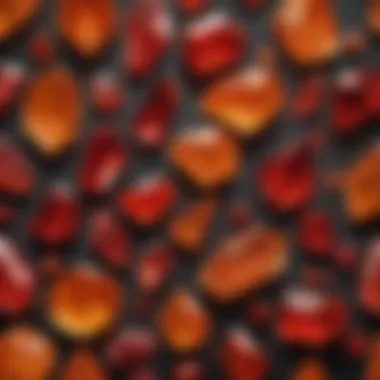
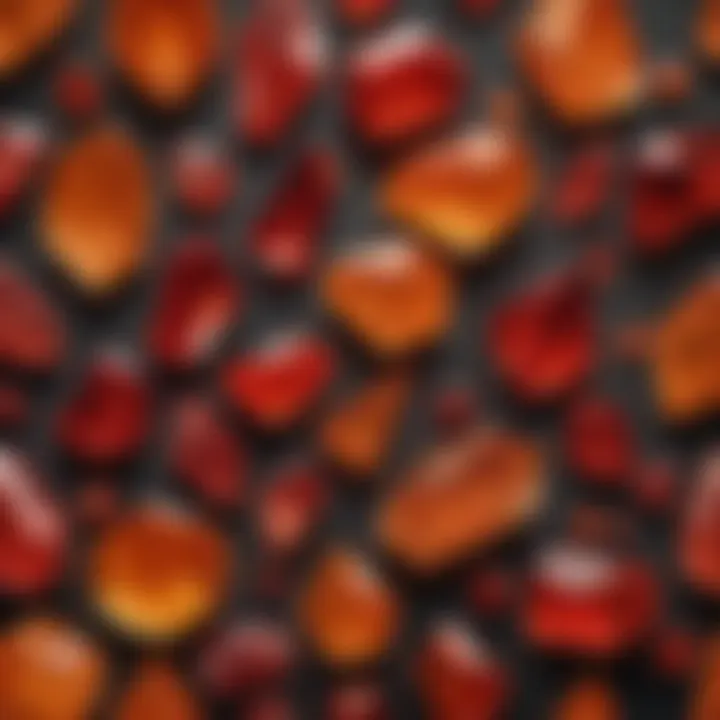
- Historical Significance: Crystals that have historical context, like those previously owned by notable figures or used in cultural rituals, tend to be more sought after.
- Personal Connection: Collectors often gravitate towards stones that resonate with them personally, whether due to emotional experiences or aesthetic preferences. A collector may choose a crystal based on the memories or sentiments tied to its acquisition.
- Provenance: Documentation of a crystal’s origin can elevate its status in a collector's eyes, offering assurance about its authenticity and value.
Researching behind-the-scenes stories and documenting your crystals can offer a richer experience in your journey through collecting. Remember, on this path, every stone has a tale to tell.
Collecting red orange crystals is not merely a hobby, but a communion with history and nature, bridging past and present.
Overall, understanding these market trends not only steers collectors in their purchases but also enriches their journey in the captivating world of red orange crystals.
Practical Tips for Collectors
Collecting red orange crystals can be both a rewarding and intricate endeavor. As diverse as they are beautiful, these crystals hold a special allure for enthusiasts and collectors alike. This section aims to provide practical advice that highlights essential elements for maintaining a quality collection, ensuring your passion remains fulfilling and engaging.
Choosing Quality Crystals
Selecting the right red orange crystals can feel like searching for a needle in a haystack, especially with the market flooded with options. First and foremost, it’s important to inspect the quality of the crystals you're considering. Look for attributes such as:
- Color: The vibrancy of the hue should catch your eye. A deep, rich coloration typically indicates high quality.
- Clarity: This involves checking for inclusions or blemishes. High-quality crystals usually offer impressive clarity, allowing light to dance within.
- Cut: A well-cut stone can significantly enhance its visual appeal. Pay attention to how light reflects off the facets.
Engaging with knowledgeable dealers can also benefit novice collectors. Don’t shy away from asking questions about the stone’s origin and quality.
Next, consider the provenance of the crystals. Knowing their history can add depth to your collection, making it not just a display of rocks but a narrative of their journey through time.
Maintenance and Care
Keeping your collection in tip-top shape is crucial. Dust and dirt are the arch-nemeses of sparkling stones. A simple wipe with a soft, lint-free cloth can do wonders. If you find them dirtier than a pig in mud, a gentle wash with lukewarm water and mild soap can help, but always avoid harsh chemicals.
Storage is another vital aspect. Consider employing:
- Soft pouches or lined boxes to prevent scratches.
- Avoid direct sunlight to protect them from fading in color.
- Separate storage for sensitive pieces to dodge unwanted scratches or cracks.
It’s worthwhile to note that some crystals can be fragile. For instance, stones that are softer on the Mohs scale, like some varieties of calcite, require extra care. Being mindful of how you handle these beauties will yield a collection that looks as fresh as the day you found them.
"Quality over quantity is the golden rule of collecting."
In summary, attention to detail when choosing and caring for red orange crystals will elevate your collection into something truly remarkable. By focusing on quality and proper handling, you not only protect your investment but also honor the stones and their unique stories.
Ethical Considerations
As the conversation about ethics in gemstone sourcing becomes increasingly prominent, understanding ethical considerations in the context of red orange crystals is crucial. The growing awareness around the origins of these stones highlights the importance of sustainability and responsible commerce, both for the environment and local communities. Ethical practices not only address the environmental impact of mining but also promote fair treatment for the workers involved in the extraction and trading processes. This section delves into these critical ethical dimensions, shedding light on the implications for collectors and enthusiasts alike.
Sourcing and Environmental Impact
The mining of red orange crystals, like any natural resource, comes with a set of environmental challenges. When discussing sourcing, it is essential to evaluate the ecological consequences linked with different mining techniques. Often, quarrying and open-pit mining can lead to habitat destruction, soil erosion, and water contamination. The ripple effects touch local ecosystems, disrupting both flora and fauna.
To mitigate these impacts, it is vital for collectors and gem enthusiasts to seek out suppliers who adhere to sustainable mining practices. Many organizations now employ techniques aimed at reducing the environmental footprint of mining operations. For instance, methods such as underground mining or secondary recovery can lessen the immediate impacts on the landscape.
Moreover, there's a push for transparency in the supply chain. Consumers are encouraged to ask about the origins of their crystals. This not only holds suppliers accountable but also ensures that their purchases contribute to responsible mining efforts, fostering a healthier relationship between the gemstone industry and the environment.
"Choosing ethically sourced stones is not merely a trend; it's a commitment to preserving the beauty of our planet for future generations."
Fair Trade Practices
In the realm of gemstones, fair trade practices play a pivotal role in promoting equity throughout the supply chain. Fair trade ensures that miners and artisans receive just compensation for their labor while also advocating for safe working conditions and community empowerment. This approach counters the exploitative dynamics commonly seen in the mining sector.
For red orange crystals, supporting fair trade initiatives can help foster sustainable livelihoods for individuals in mining regions. Engaging with businesses that prioritize fair trade resonates with the broader consumer values of social responsibility and ethical consumption. It often translates to improved community health, access to education, and infrastructure development.
Some notable fair trade certified organizations provide assurance that the products they're selling adhere to high ethical standards. By purchasing gemstones from these sources, collectors send a message that they value not just the beauty of the crystals but also the process and people behind them.
By understanding and engaging with these ethical considerations, gemstone enthusiasts can make informed decisions that respect both the earth and its inhabitants, enhancing their overall experience with red orange crystals.
Epilogue
As we wrap things up, the exploration of red orange crystals unfolds several layers of significance. These stunning gems are more than just eye candy; they represent a confluence of natural artistry and cultural heritage. From understanding their geological formation to recognizing their metaphorical powers, every facet enriches our appreciation.
Recap of Key Insights
Throughout this article, we covered numerous aspects that underscore the importance of red orange crystals. Here's a quick summary of the insights:
- Geological Formation: We examined how specific mineral compositions contribute to the vibrant colors of these crystals. Natural processes, like volcanic activity, play prime roles in their creation.
- Visual and Metaphysical Properties: The color variants and cut quality affect not only their aesthetic allure but also their perceived energies and emotional benefits in many cultures.
- Historical Context: We dove deep into ancient civilizations that treasured these gems, linking them to power and spirituality, thus revealing their historical significance.
- Modern Applications and Market Trends: The adaptability of red orange crystals in contemporary fashion and jewelry, as well as market valuation and collectibility factors, showcase their ongoing relevance.
Recapping these key points sheds light on why they matter in both aesthetic and spiritual dimensions.
Future of Red Orange Crystals in the Market
Looking ahead, the future of red orange crystals appears vibrant and full of potential. As consumer awareness grows, so does the demand for ethically sourced gemstones. Here are some trends that may shape their future:
- Sustainability Concerns: With the rise in eco-consciousness, buyers are increasingly focused on the sources of their crystals. Crystals that are sustainably mined and certified as fair trade are likely to gain traction.
- Fusion with Technology: There might be innovative ways to integrate crystals into wearable technology or smart jewelry, enhancing their value as both decorative and functional pieces.
- Growing Interest in Metaphysical Properties: As more individuals explore holistic wellness, the spiritual benefits associated with these crystals might also see a resurgence in popularity.
Ultimately, the narrative surrounding red orange crystals weaves together history, culture, and personal expression—elements that continue to resonate with today’s discerning collectors and jewelry enthusiasts.







